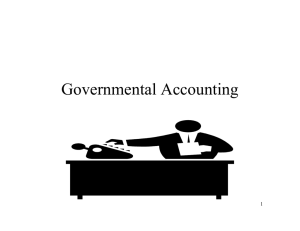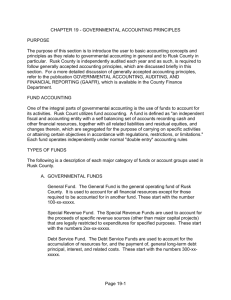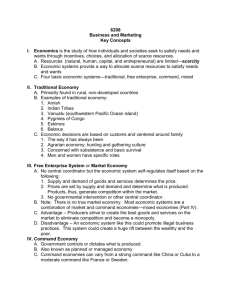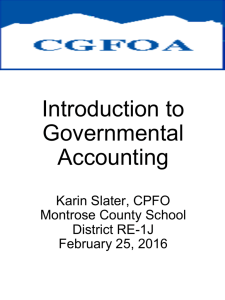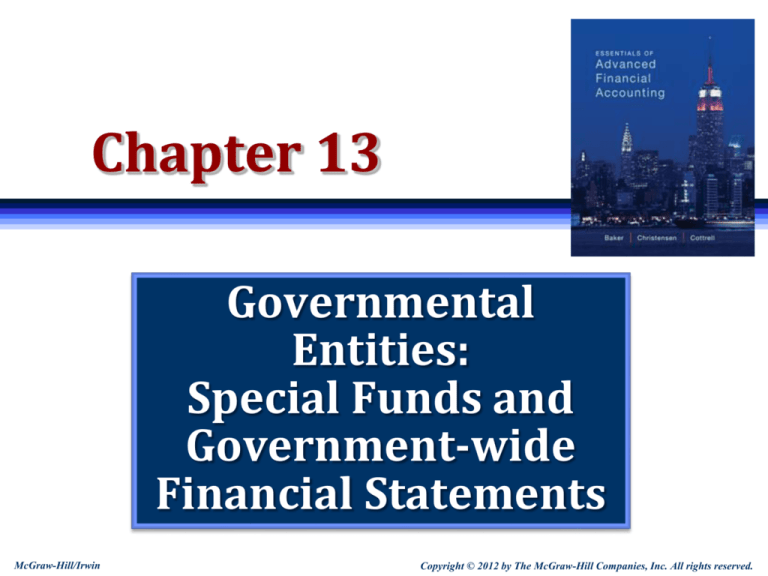
Chapter 13
Governmental
Entities:
Special Funds and
Government-wide
Financial Statements
McGraw-Hill/Irwin
Copyright © 2012 by The McGraw-Hill Companies, Inc. All rights reserved.
Learning Objective 1
Understand and explain the
differences in financial
reporting requirements of
the different fund types.
13-2
Big Picture
A government should establish those funds
required by law and the specific operating
and management needs of the government
entity.
Figure 18-2 summarizes the different types
of funds.
13-3
Overview of Accounting and Financial Reporting for
Governments
13-4
The Governmental Funds:
General Fund (#1 of 5)
General rule:
All activities should be accounted for in the
general fund unless specifically required by law
or
The nature of the activities is proprietary or
fiduciary.
We discussed the general fund in chapter 12.
13-5
The Governmental Funds:
Special Revenue Funds (#2 of 5)
Purpose: To account for the proceeds of specific
revenue sources that are legally restricted to
expenditure for specific purposes.
With the exception of inflows for Capital projects and
Expendable trusts.
Includes resources and expenditures for operations, such
as public libraries, when a separate tax is levied for their
support.
Inflows: Usually from specific taxes or nontax
sources not directly related to services provided.
A General Fund “clone”—identical accounting.
Thus, we don’t discuss them in detail here.
13-6
Governmental Funds Worksheets
Each of the five governmental funds will
report two fund-based financial statements:
The Balance Sheet
The Statement of Revenues, Expenditures, and
Changes in Fund Balance
13-7
Worksheet for the Balance Sheet for the
Governmental Funds
13-8
Worksheet for the Statement of Revenues, Expenditures, and Changes in
Fund Balances for the Governmental Funds
13-9
Practice Quiz Question #1
Which of the following statements is true
about fund accounting?
a. An enterprise fund is an example of
fiduciary fund.
b. Most transactions of a state or municipal
government are accounted for in the
general fund.
c. A capital projects fund is an example of
proprietary fund.
d. Most transactions of a state or municipal
government are accounted for in the
internal service fund.
13-10
Practice Quiz Question #1
Which of the following statements is true
about fund accounting?
a. An enterprise fund is an example of
fiduciary fund.
b. Most transactions of a state or municipal
government are accounted for in the
general fund.
c. A capital projects fund is an example of
proprietary fund.
d. Most transactions of a state or municipal
government are accounted for in the
internal service fund.
13-11
Learning Objective 2
Make calculations and
record journal entries for
capital projects funds.
13-12
The Governmental Funds:
Capital Projects Funds (#3 of 5)
Purpose: To account for financial resources
used for the acquisition or construction of
major capital facilities
Except for those financed by:
Proprietary Funds and
Trust Funds
13-13
The Governmental Funds:
Capital Projects Funds (#3 of 5)
A temporary fund related to the acquisition
or construction of a specific capital project.
At the completion of the project:
The fund is closed and
The project ’s cost is recorded as a capital asset
in the GCA-GLTL general ledger.
Outflows: Costs incurred during construction are
charged to expenditures.
Inflows: Bond sales and transfers from the
General Fund.
13-14
GCA-GLTL General Ledger
Since governmental funds only report
current resources and obligations, the longterm assets and liabilities are recorded in
another location..
GCA = General Capital Assets
GLTL = General Long Term Liabilities
GCA-GLTL General Ledger
13-15
The Governmental Funds:
Capital Projects Funds (#3 of 5)
Things to remember:
Fixed assets or depreciation are not recorded in capital
projects funds
Long-term debt is not recorded in capital projects funds
Capital projects funds typically do not have operating
budgets
A capital budget is prepared as a basis for selling bonds
to finance a project, and the capital budget is the control
mechanism for the length of the project
The capital budget for the project may, or may not, be
formally recorded in the accounts
The fund records capital outlays as expenditures
13-16
Practice Quiz Question #2
Which of the following statements is true
about capital projects funds?
a. Capital projects funds record depreciation.
b. Capital projects funds are permanent
because long-term assets remain in the
fund until disposal.
c. Capital projects funds are required by law
to have operating budgets.
d. When a capital project is completed, the
fund is closed and the asset is tranferred to
the GCA-GLTL general ledger.
13-17
Practice Quiz Question #2
Which of the following statements is true
about capital projects funds?
a. Capital projects funds record depreciation.
b. Capital projects funds are permanent
because long-term assets remain in the
fund until disposal.
c. Capital projects funds are required by law
to have operating budgets.
d. When a capital project is completed, the
fund is closed and the asset is tranferred to
the GCA-GLTL general ledger.
13-18
Learning Objective 3
Make calculations and record
journal entries for debt service
funds.
13-19
The Governmental Funds:
Debt Service Funds (#4 of 5)
Purpose: To account for the servicing of debt
initially recorded as a liability in the GCA-GLTL
general ledger.
“Servicing of Debt” is the payment of
(1) interest and
(2) debt principal at maturity.
The accounting is the same as for the general fund.
Unusual Features:
Interest is not accrued until the due date.
Principal payments are not recorded as liabilities until
the due date.
13-20
Debt Service Funds
Examples of general long-term debt
obligations:
Serial bonds
Term bonds
Special assessment bonds
Notes and warrants
Capital leases
13-21
Special Assessments
Special Assessments are
Assessments made against taxpayers (citizens or
businesses) that directly benefit from
improvements.
Examples: sidewalks, street lighting, gutters
Special Assessment Bonds are usually issued
to initially pay for the improvements.
Over time, the special assessments levied against
taxpayers are used to pay off the bonds.
All construction activity takes place in a Capital
Projects Fund.
13-22
The GCA-GLTL General Ledger
Purpose of GCA-GLTL General Ledger:
Accounts for capital assets (at historical cost)
and
Long-term debt not accounted for in Enterprise
Funds, Internal Service Funds, or Trust Funds.
The GCA-GLTL General Ledger is not a fund
It has no cash for paying liabilities.
It is a self-balancing set of accounts.
13-23
General Capital Assets
Categories of Assets
Land
Buildings
Improvements other than buildings
Equipment
Construction work in progress (being performed
by Capital Projects Funds)
Infrastructure assets (see next slide)
13-24
General Capital Assets: Infrastructure Assets
Capitalization is mandatory for public domain or
“infrastructure” capital assets such as:
Streets and roads
Sidewalks
Bridges and tunnels
Water and sewer systems
Lighting systems
Characteristics of infrastructure
Stationary in nature
Normally preserved longer than other capital assets.
13-25
General Capital Assets: Post-capitalization Periods
Depreciation is mandatory—
except for certain infrastructure
assets:
Depreciation Expense is never
reported in the operating statement
of governmental funds.
It is reported only in the two
government-wide statements.
Sales of Assets: record proceeds as
other financing sources in General
Fund.
13-26
General Long-term Liabilities
Examples of Debt Recorded in GCA-GLTL
general ledger
General obligation bonds (usually issued to
pay for capital projects).
Claims and judgments.
Compensated absences (vacation & sick pay).
Unfunded pension contributions.
Capital leases payable.
Special assessment debt having government
commitment (explained earlier).
13-27
General Long-term Debt Liabilities
Liquidation of GLTL
Debt Issuance Liabilities: at the maturity date,
the liability is transferred to a Debt Service Fund.
Nondebt Issuance Liabilities: at the payment
date, the liability is transferred to the General
Fund.
Note that the GLTL is not removed from the
GCA-GLTL general ledger when it becomes a
current liability (due within 12 months).
13-28
Practice Quiz Question #3
Which of the following statements is true?
a. Long-term debt resides permanently in
the debt service fund.
b. The GCA-GLTL General Ledger services
interest payments on long-term debt.
c. Special assessments are levied against
the general population.
d. A debt service fund only makes interest
and principal payments.
e. Debt service funds accrue liabilities as
incurred.
13-29
Practice Quiz Question #3
Which of the following statements is true?
a. Long-term debt resides permanently in
the debt service fund.
b. The GCA-GLTL General Ledger services
interest payments on long-term debt.
c. Special assessments are levied against
the general population.
d. A debt service fund only makes interest
and principal payments.
e. Debt service funds accrue liabilities as
incurred.
13-30
Learning Objective 4
Make calculations and record
journal entries for permanent
funds.
13-31
The Governmental Funds:
Permanent Funds (#5 of 5)
Permanent Funds:
Are established when there is a donor restriction
requiring that
the fund principal be preserved and
the income from these permanent funds be used
to benefit the government’s programs or its
general citizenry.
The accounting for permanent funds is similar
to that of the general fund.
13-32
Practice Quiz Question #4
Which of the following is NOT true about
permanent funds?
a. The principal of permanent funds is usually
required to be preserved.
b. The income from permanent funds is usually
allowed to be spent for the benefit of the
governmental entity and its citizens.
c. Permanent funds are accounted for in the
general fund.
d. The accounting for permanent funds is
similar to the accounting in the general fund.
e. Permanent funds usually have donor
restrictions.
13-33
Learning Objective 5
Understand and explain how
governmental funds are
reported and rules for separate
reporting as major funds.
13-34
Governmental Funds Financial Statements
Required financial statements
1. The Governmental Funds Balance Sheet
2. The Governmental Statement of Revenues,
Expenditures, and Changes in Fund Balance.
These statements are prepared for each
individual governmental fund
These individual fund statements are the
foundation for the financial statements prepared
for the governmental entity.
13-35
Governmental Funds Financial Statements
Major funds must be reported in separate columns
GASB 34 specifies that the general fund is always a
major fund.
Major funds: revenues, expenditures or expenses,
assets, or liabilities >=
10% of the total for their fund category or type
(governmental or enterprise) and
5% of the aggregate amount for all governmental and
enterprise funds
Nonmajor funds are
Aggregated and reported in a separate column (labeled
“other governmental funds”).
13-36
Practice Quiz Question #5
Which of the following is NOT true about
governmental reporting?
a. The special revenues fund is always a
major fund.
b. Non-major funds are aggregated and
reported in a single column.
c. The general fund is always a major fund.
d. Major funds are defined as those that
constitute at least 10% of their fund
category or 5% of all funds.
13-37
Learning Objective 6
Make calculations and record
journal entries for enterprise
funds.
13-38
The Proprietary Funds: Enterprise Funds
Enterprise Funds account for activities
that provide services primarily to the public
Examples: Gas, electric, water utilities
Accounting like business accounting.
Measurement focus on all economic
resources and the accrual basis of
accounting.
Report fixed assets, which are
depreciated, and long-term debt.
Focus on income determination and
capital maintenance.
13-39
Practice Quiz Question #6
Which of the following statements is true
about enterprise funds?
a. The activities accounted for in enterprise
funds primarily benefit other
government units.
b. The accounting for enterprise funds is
similar to the accounting for businesses.
c. Enterprise never report long-term
assets or depreciation.
d. A maintenance service center for public
busses other city vehicles is an example
of an activity accounted for in an
enterprise fund.
13-40

